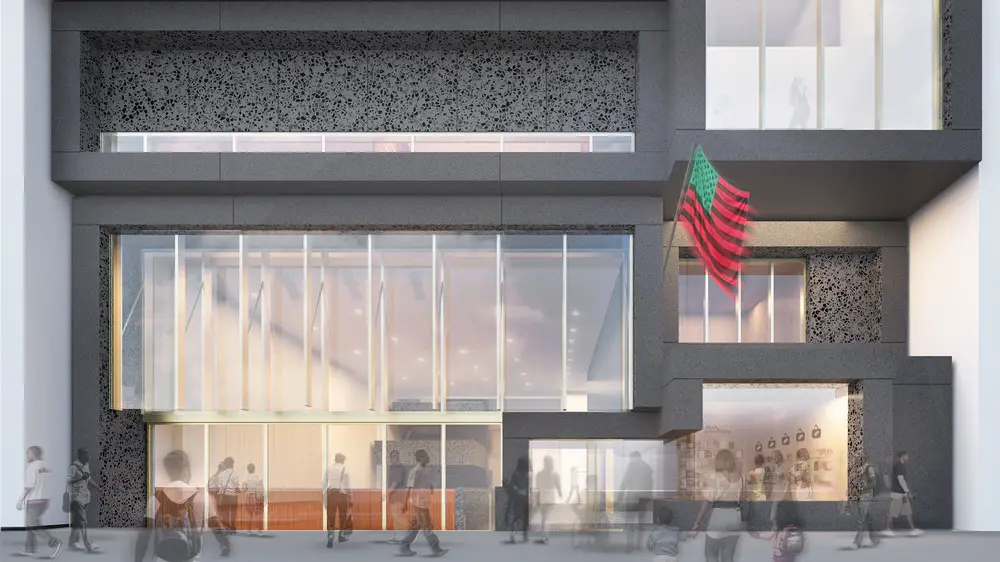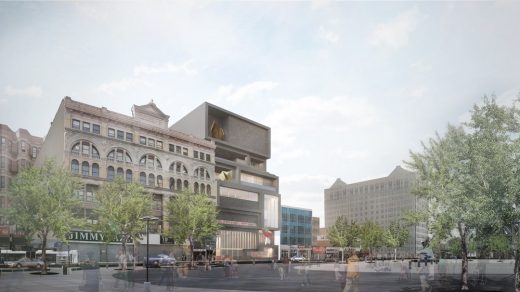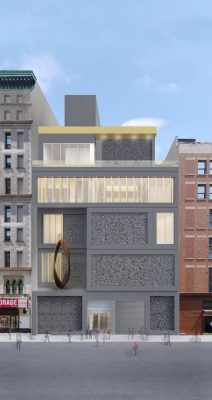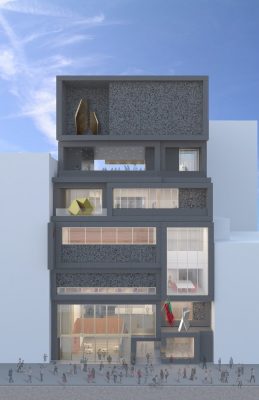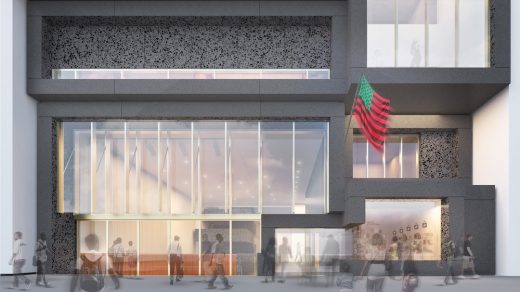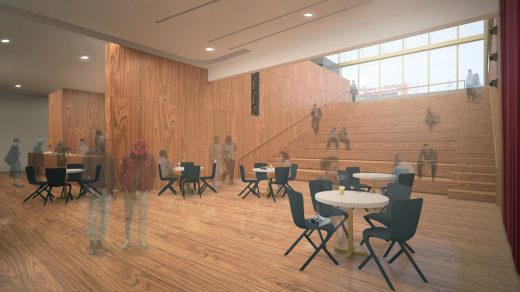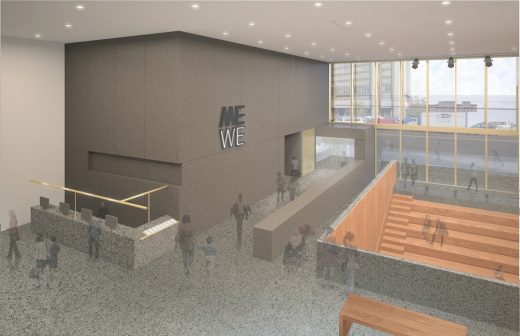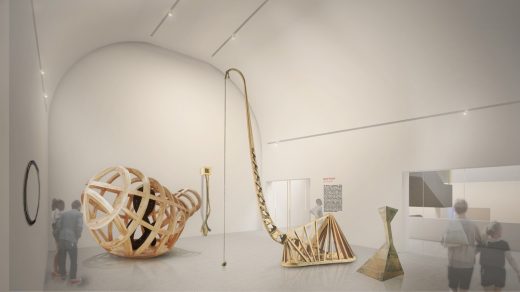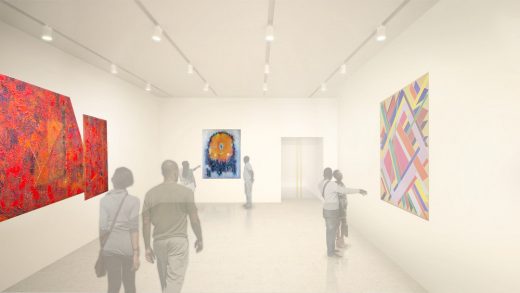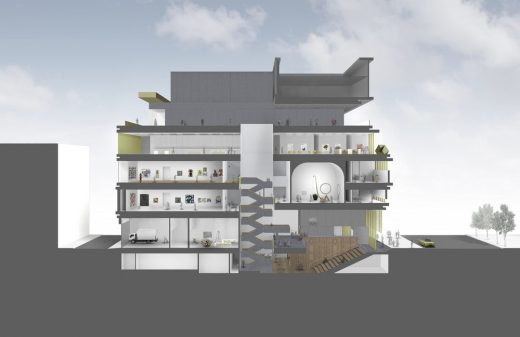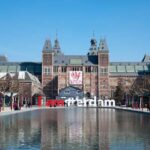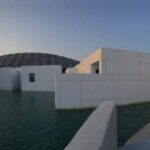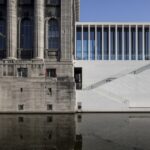Studio Museum Harlem Development, New York City Building, Architect, Images
Studio Museum in Harlem
144 W 125th Street Building Development, Manhattan, NY, USA – design by David Adjaye
Sep 28, 2017
Studio Museum in Harlem to Break Ground Late Fall 2018
Design: David Adjaye Architect
Location: 144 W 125th St, New York, NY 10027, United States
Museum Unveils Design for 82,000-Square-Foot Building and Announces $175 Million Capital Campaign, as It Looks Ahead to Its 50th Anniversary
Thelma Golden, Director and Chief Curator of The Studio Museum in Harlem, and Raymond J. McGuire, Chairman of the Board of Trustees, today announced that the historic groundbreaking for the Museum’s new building, designed by Adjaye Associates in collaboration with Cooper Robertson, will take place during the 50th anniversary year of 2018. The completion of design development and the success of the quiet phase of the fundraising effort now make it possible to envision a late fall 2018 start for construction of this new home for the Studio Museum, the premier center for contemporary artists of African descent, the principal visual art institution in Harlem, and a magnet for visitors from around the world.
With plans for the building having received a warm welcome from the community and enthusiasm and support from New York City officials, the Studio Museum today unveiled the design and made public a capital campaign led by the Board of Trustees, with a goal of $175 million to meet hard and soft construction costs, provide an operating and capital reserve, and build endowment. A range of education and community programs inaugurated as part of the celebration of the 50th anniversary will ensure that the Studio Museum remains a vital presence in Harlem and throughout the art world during the construction period.
Undertaken as a public-private initiative in partnership with the City of New York, the entirely new 82,000-square-foot building will rise on West 125th Street on the site of the current facility, a centuryold commercial building that was adapted for the Studio Museum in the early 1980s by late AfricanAmerican architect J. Max Bond Jr. The new building is designed to express the Museum’s core values of openness and engagement as they have been lived throughout a five-decade history of innovative and impactful exhibitions and programs, while also providing exceptional new spaces to elevate the Museum’s service to artists, audiences, the uniquely vibrant Harlem community, and the world of art.
Thelma Golden said, “We are thrilled to announce that during our 50th anniversary year, we will begin construction on the single biggest initiative the Studio Museum has ever undertaken, making David Adjaye’s brilliant design a reality. We look back with pride on our legacy, so much of which has been built within the space that Max Bond renovated for us. We look forward to constructing a building that provides unprecedented resources for our work and creates a superb new cultural landmark for Harlem and the entire City of New York.”
Support for the Studio Museum’s Building Project
The Studio Museum revealed that the quiet phase of fundraising has already achieved 70 percent of the capital campaign goal of $175 million, thanks to generous support from the City of New York as lead partner and to private individuals, foundations, and corporations. The City has committed $53.8 million toward construction of the new building, with funding coming from the Mayor’s Office, the City Council, and the Manhattan Borough President’s Office through the Department of Cultural Affairs. This includes over $13 million in new funding added in this year’s City capital budget, and the City Council is anticipated to commit an additional $9 million over the next two years. Other public and private funding, including a broad national coalition of philanthropists, business leaders, and art world leaders, accounts for another $62 million.
Raymond J. McGuire, Chairman of the Board of Trustees, said, “We are deeply grateful for the outpouring of support we have received to date from the City, our private donors, and the Trustees. In their generosity, they reflect and honor the feelings of artists and arts professionals, the Harlem community, and a public from around the world who are committed to the Studio Museum. Fifty years ago, our visionary founders answered the urgent and necessary call for this institution to come into existence. Since then, its work has proved to be instrumental in transforming the entire cultural landscape. Literally hundreds of vital artists, and the countless people who have been touched by their creations, can look back today and say in wonder and gratitude that, if not for the Studio Museum, the cultural world would be a vastly different place. Now, as we begin the next half-century of our history, we look forward in confidence to the great things we will do in our new building, designed especially to manifest our extraordinary mission and program.”
“For nearly fifty years, the Studio Museum has been a trailblazer in the cultural conversation, fostered the careers of emerging artists of African descent, and served as an anchor in Harlem,” said Mayor Bill de Blasio. “We are excited about the unique potential that the Museum’s new home brings with it. As they embark on creating a one-of-a-kind space to serve as a platform for the creative work of the artists from around the world, the Studio Museum is poised to have an even greater impact on the Harlem community, the City of New York, and the global cultural conversation.”
“The Studio Museum in Harlem is an iconic institution that is as vital and relevant as it has ever been in its nearly 50-year history,” said NYC Cultural Affairs Commissioner Tom Finkelpearl. “We are proud to make a major investment in the museum as it transforms itself into an even better platform for artists of African descent and an incubator for new talent. I applaud Thelma Golden, Ray McGuire and the Studio Museum Board for their inspired leadership and look forward to seeing David Adjaye’s visionary design become a reality.”
This support is echoed by the Museum’s newly formed Community Advisory Network, a group of Harlem stakeholders convened to work with the Museum to ensure that the needs and aspirations of neighborhood residents are heard and addressed. Members of the Community Advisory Network represent more than twenty stakeholder groups, including Community Board 10, the New York City Housing Authority, the New York City Parks Department, the Office of the Manhattan Borough President, the NYPD’s 28th Precinct, the New York Public Library’s George Bruce Branch, churches, educational institutions, fellow cultural organizations, Harlem service organizations, the 125th Street Business Improvement District, and alumni of the Studio Museum’s Artist-in-Residence program.
“For almost half a century, the Studio Museum has been a jewel of the Harlem community,” said Manhattan Borough President Gale A. Brewer. “I’m proud to support this great institution as it prepares to build a wonderful new home, so that it can do even more to represent Harlem with integrity and authenticity.”
Melissa Mark-Viverito, Speaker of the New York City Council, said, “The Studio Museum is helping inspire the next generation of artists of color while paying respect to the vibrant history of Upper Manhattan, including the El Barrio/East Harlem area. I am glad to invest in their success in serving diverse audiences, especially those in my district. The Council is proud to advance the Museum’s work as both a showplace of art and a remarkable incubator of creativity —and as we look toward a future vision of Harlem, we must continue to support all arts and cultural institutions along the 125th Street Corridor. I will continue to work with my colleagues on the Council to look for ways to preserve and promote the arts throughout the City.”
“The Studio Museum in Harlem is a shining example of how a culturally specific institution, deeply rooted in its own neighborhood, can also be a global leader in its outlook and impact,” said New York City Council Majority Leader Jimmy Van Bramer. “The City’s significant investment in the Studio Museum is truly an investment in the future of the cultural sector in New York and shows how our capital investments in cultural organizations and institutions create place, identity and a future for the heart and soul of our City.”
Bill Perkins, City Council Member for District 9, said, “Whether you look at it from the viewpoint of education, the economy, civil rights and civil liberties, or the sheer joy of great art, The Studio Museum in Harlem is an institution we must support, now and in the future. It is truly our beacon—and with its new building, it will shine more brightly than ever.”
The Design of the New Studio Museum
The design for the new Studio Museum provides:
• an increase of approximately 115 percent in space for exhibiting art and conducting the Artistin-Residence program, from the existing 8,050 square feet to almost 17,300 square feet,
• an increase of some 47 percent in indoor space for education, public programs, and public amenities, from 6,340 square feet to more than 9,300 square feet,
• and an increase in outdoor space of 105 percent, from 3,900 square feet to almost 8,000 square feet.
The 82,000-square-foot structure will have:
• a lower level for presentations (lectures, screenings, performances, educational activities, etc.), a welcome center, a café, and public amenities,
• five floors at street level and above,
• and a roof terrace spanning the entire building.
Galleries for temporary exhibitions and the Studio Museum’s unparalleled permanent collection are provided on the second, third, and fourth floors. An education center occupies part of the third floor, adjacent to a double-height gallery with a barrel-vaulted ceiling. The fourth floor accommodates both an exhibition gallery and dedicated spaces for the signature Artist-inResidence program, which puts the “Studio” in the Museum’s name. Staff offices are located on the fifth floor, and the roof is designed for use as a terrace and event space. Niches on the facade on both the 125th and 124th Street sides of the building will display outdoor sculpture. Artworks will permeate the entire interior of the building as well—in the graciously proportioned formal galleries provided with fine-art temperature and humidity controls, and (for less sensitive objects) in the public corridors and common areas.
“It has been an honor to work alongside Thelma Golden, the Board of Trustees, and the entire Studio Museum team to craft a new home for the Studio Museum—one that will build on the museum’s incredible legacy and deepen its relationships with the local community and an expanding global audience. Above all, we have sought to create spaces that celebrate the rich heritage of the institution, its relationship with artists and its role as a pillar of Harlem’s cultural life. Inspired by the architectural character of the neighborhood and featuring various scales of gallery space that speak to the diverse needs of contemporary artists, the design seeks to ensure that artistic dialogue remains at the heart of the Museum,” said Sir David Adjaye.
Taking its cues from the brownstones, churches, and bustling sidewalks of Harlem, David Adjaye’s design provides the Studio Museum with a dynamic, sculptural facade that contrasts strongly with the surrounding commercial buildings. The building has a porous, welcoming presence at street level, a light-filled core that soars up through the entire interior, and a tiered public hall, which the architect has likened to an “inverted stoop” that invites people to step down from the street into a multiuse space that will be free and open to the public during Museum hours and used for presentations and informal gatherings.
The masonry-framed windows of Harlem’s vernacular architecture find an echo in the rhythmic composition of the facade, with its textured, precast concrete and windows of varying proportions. The radiant, soaring volumes of Harlem’s sanctuaries find a counterpart in the top-lit central hall, with its ample wall area for large-scale artworks and its switchback stair, which provides multiple lookout points from its landings. A wide set of pivoting glass doors, which can be opened in differing configurations, draws directly on the convivial bustle of West 125th Street by establishing a transparent secondary entrance that leads directly to the descending step/seats of the tiered public hall.
Fall 2017: A Last Look at the Historic Studio Museum
While the Studio Museum prepares to begin construction in 2018, its fall 2017 schedule presents the final group of exhibitions that will be shown in the existing building.
On view through January 7, 2018, these exhibitions include:
• Fictions, a major survey of recent work by emerging artists of African descent that emphasizes the development of narrative content in recent years,
• We Go as They, featuring works created at the Studio Museum by its 2016–17 artists in residence, Autumn Knight, Julia Phillips, and Andy Robert,
• and Their Own Harlems, organized in honor of the centennial of the birth of Jacob Lawrence (1917–2000), with works by some twenty artists of different generations reflecting on Harlem as both an actual neighborhood and a symbolic place.
While these exhibitions offer the public a last chance to visit the historic galleries, the Studio Museum will also be looking ahead. Its autumn Gala, held this year on October 30, will honor David Adjaye in recognition of the outstanding vision he has brought to the Studio Museum and the world at large.
Programs Inaugurated or Expanded During the 50th Anniversary Year
The final exhibition season in the current building will close on January 7, 2018. But as preparations are made to begin construction, the Studio Museum will be ramping up its work throughout 2018 to continue to bring the Museum’s mission to life in new local, national and international contexts, as it prepares to celebrate in September the 50th anniversary of the Museum’s opening.
Thelma Golden said, “Our roster of programs, exhibitions, and activities during our anniversary celebrations in 2018 and 2019 will take place in Harlem, throughout New York, and far afield. Even while we build, we will aim to spread the excitement, insight, and inspiration of the artists we represent and serve.”
The Museum will continue its highly praised inHarlem initiative of presenting exhibitions, artists’ projects, and programs throughout the neighborhood in collaboration with partners such as the New York City Department of Parks & Recreation, Marcus Garvey Park Alliance, Historic Harlem Parks Coalition, New York Public Library, Maysles Documentary Cinema, AFROPUNK, Harlem Stage, The Laundromat Project, New East Harlem Merchants Association, Barnard College, and other cultural institutions. The new initiatives will build on the success of projects such as the 2016 installation of outdoor sculptures by artists Kevin Beasley, Simone Leigh, Kori Newkirk, and Rudy Shepherd, and the 2017 exhibition Derrick Adams: Patrick Kelly, The Journey at the Countee Cullen Branch of the New York Public Library.
The Studio Museum’s award-winning education and public programs for all ages will find new homes throughout Harlem, continuing the Museum’s longtime engagement with partners and participants and reaching new audiences where they are.
• The New York Public Library’s George Bruce Library at 518 West 125th Street is the new home for Books, Authors & Kids! and Studio Salon, the Museum’s literary series for children and adults, respectively.
• A unique academic program organized by the Barnard Center for Research on Women and the Department of Africana Studies at Barnard College, The Harlem Semester encourages students to learn about Harlem’s history through immersion in the neighborhood under the mentorship of key cultural organizations, including the National Black Theatre, Apollo Theater, Harlem Stage Gatehouse, Schomburg Center for Research in Black Culture, National Jazz Museum in Harlem, and Romare Bearden Foundation. The third Harlem Semester will begin in spring 2018.
• The Studio Museum’s eponymous Artist-in-Residence program will continue during the inHarlem period. The 2018 residents and their studio location will be announced later in 2017.
• Expanding the Walls, the Museum’s rigorous, eight-month teen photography program, will also continue during inHarlem.
• Artist talks, panels, screenings and hands-on workshops for adults will continue to take place throughout the neighborhood in new venues.
• Family programs, including the Museum’s beloved Lil’ Studio program, will also move to library and community locations.
New inHarlem initiatives for 2018 will include a substantial focus on the Museum’s unparalleled permanent collection. The Museum is currently finishing an initiative to gather high-quality digital images of the collection. Collection images and information form an increasingly important part of the Museum’s website, which was relaunched in an upgraded, mobile-responsive form in September 2017.
The collection will also find a significant place in local schools through new resources for teachers and students. Downloadable lesson plans featuring works from the collection will be made available on studiomuseum.org for use in classrooms locally, nationally, and internationally. The Museum’s educators and teaching artists will also bring innovative lesson plans and hands-on activities, based on investigations of the permanent collection, to students at the Museum’s partner schools in Harlem.
And in fall 2018, the Museum will launch a program to place reproductions of iconic collection works at public sites throughout Harlem, including in schools.
The Museum’s capacity to celebrate its history and make its artworks accessible to the public will be increased during this period through a new archive initiative. Over the course of three years, the initiative will organize and index the Museum’s historical materials so that a formal Museum archive will be accessible to researchers and scholars for the first time.
Looking beyond 2018, the Museum will partner with the American Federation of Arts in 2019–21 to offer a touring exhibition of selections from the Museum’s collection to six venues around the country.
About The Studio Museum in Harlem
Founded in 1968 by a diverse group of artists, community activists, and philanthropists, The Studio Museum in Harlem is internationally known for its catalytic role in promoting the work of outstanding artists of African descent. Now approaching its 50th anniversary, the Studio Museum is preparing to construct a new home at its current location on Manhattan’s West 125th Street, designed by internationally renowned architect David Adjaye with Cooper Robertson as the first building created expressly for the institution’s program. The new building will enable the Studio Museum to better serve a growing and diverse audience, provide additional educational opportunities for people of all ages, expand its program of world-renowned exhibitions, effectively display its singular collection, and strengthen its trailblazing Artist-in-Residence program.
The Artist-in-Residence program was one of the institution’s founding initiatives and is the reason why “Studio” is in the name. The program has supported more than one hundred emerging artists of African or Latino descent, many of whom who have gone on to highly regarded careers. Alumni include Chakaia Booker, David Hammons, Kerry James Marshall, Julie Mehretu, Wangechi Mutu, Mickalene Thomas, and Kehinde Wiley.
The collection includes nearly two thousand paintings, sculptures, works on paper, prints, photographs, mixed-media works, and installations dating from the nineteenth century to the present. Artists represented include Romare Bearden, Robert Colescott, Jacob Lawrence, Norman Lewis, Chris Ofili, Betye Saar, Lorna Simpson, Kara Walker, and Hale Woodruff, as well as many former artists in residence. The Studio Museum is the custodian of an extensive archive of the work of photographer James VanDerZee, the renowned chronicler of the Harlem community from 1906 to 1983.
The Studio Museum’s exhibitions expand the personal, public, and academic understanding of modern and contemporary work by artists of African descent. A wide variety of on- and off-site programs brings art alive for audiences of all ages—from toddlers to seniors—while serving as a bridge between artists of African descent and a broad and diverse public. A leader in scholarship about artists of African descent, the Studio Museum publishes Studio magazine twice a year and creates award-winning books, exhibition catalogues, and brochures.
Hours and Admission
The Studio Museum is open Thursday and Friday, noon–9pm; Saturday, 10am–6pm; and Sunday, noon–6pm. The museum is closed to the public but available for school and group tours on Monday, Tuesday, and Wednesday. Museum admission is by suggested donation: $7 for adults, $3 for students (with valid ID) and seniors. Free for children 12 and under. Sundays are free at the Studio Museum, thanks to generous support from Target. For more information visit studiomuseum.org
Studio Museum in Harlem to Break Ground images / information received 280917
Location: 144 W 125th St, New York, NY 10027, United States
New York City, USA
New York City Architecture
Contemporary New York Buildings
Manhattan Architecture Designs – chronological list
New York City Architecture Tours by e-architect
Harlem Architecture
Alexander Hamilton’s Home, Relocated and Restored by John G Waite Associates, in Harlem
Hamilton Grange Harlem
Harlem Tower Building
Design: Swanke Hayden Connell Architects
Harlem Park
The Harlem Edge
The Harlem Edge Exhibition
Dream Downtown Hotel, Cheslea
Comments / photos for Studio Museum in Harlem to Break Ground page welcome
Website: David Adjaye, Architect

